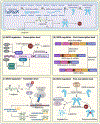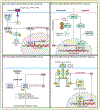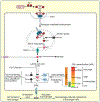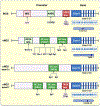Inducible nitric oxide synthase (iNOS): More than an inducible enzyme? Rethinking the classification of NOS isoforms
- PMID: 40389042
- PMCID: PMC12161154
- DOI: 10.1016/j.phrs.2025.107781
Inducible nitric oxide synthase (iNOS): More than an inducible enzyme? Rethinking the classification of NOS isoforms
Abstract
Nitric oxide (NO) is a critical signaling molecule synthesized from L-arginine by nitric oxide synthase (NOS). The three NOS isoforms-neuronal NOS (nNOS; NOS1), inducible NOS (iNOS; NOS2), and endothelial NOS (eNOS; NOS3)-have traditionally been classified as either constitutive (nNOS and eNOS) or inducible (iNOS). However, this binary classification oversimplifies their functions, particularly by neglecting the physiological roles of iNOS and misrepresenting its involvement in pathological processes. Increasing evidence demonstrates that all three isoforms can exhibit both constitutive and inducible expression. Notably, iNOS is constitutively expressed at low levels in several tissues, including blood, heart, bone marrow, lung, brain, spinal cord, retina, colonic mucosa, liver, ileum, skeletal muscle, epidermis, adipose tissue, endometrium, ovary, and kidney under normal physiological conditions, a form we refer to as constitutive iNOS (ciNOS). This basal expression contributes to essential functions such as heart rate regulation, respiratory exchange, and microbiome balance in the gut. Moreover, in certain pathological contexts, iNOS may exert protective rather than harmful effects, challenging the prevailing view that it is solely a pro-inflammatory mediator. Current drug development strategies targeting NOS are largely based on the outdated dichotomy of constitutive "physiologic" versus inducible "pathologic" isoforms, focusing primarily on iNOS inhibition. The failure of iNOS inhibitors in most clinical trials highlights the limitations of this approach. To address these gaps, we propose a revised nomenclature that incorporates both gene expression mode (constitutive vs. inducible) and discovery order, offering a more nuanced framework for understanding NOS isoforms in both health and disease.
Keywords: Constitutive inducible nitric oxide synthase; Constitutivity; Inducibility; Nitric oxide.
Copyright © 2025 The Authors. Published by Elsevier Ltd.. All rights reserved.
Conflict of interest statement
Declaration of Competing Interest The authors declare no conflict of interest.
Figures





Similar articles
-
Contribution of nitric oxide synthase isoforms to cholinergic vasodilation in murine retinal arterioles.Exp Eye Res. 2013 Apr;109:60-6. doi: 10.1016/j.exer.2013.01.012. Epub 2013 Feb 19. Exp Eye Res. 2013. PMID: 23434456
-
Nitric oxide synthase: non-canonical expression patterns.Front Immunol. 2014 Oct 9;5:478. doi: 10.3389/fimmu.2014.00478. eCollection 2014. Front Immunol. 2014. PMID: 25346730 Free PMC article. Review.
-
Expression of nitric oxide synthase isoforms in the mouse kidney: cellular localization and influence by lipopolysaccharide and Toll-like receptor 4.J Mol Histol. 2005 Oct;36(8-9):499-516. doi: 10.1007/s10735-006-9028-7. Epub 2006 May 19. J Mol Histol. 2005. PMID: 16733795
-
Partial cloning of constitutive and inducible nitric oxide synthases and detailed neuronal expression of NOS mRNA in the cerebellum and optic tectum of adult Atlantic salmon (Salmo salar).Brain Res Mol Brain Res. 2000 May 31;78(1-2):38-49. doi: 10.1016/s0169-328x(00)00066-8. Brain Res Mol Brain Res. 2000. PMID: 10891583
-
Inducible nitric oxide synthase: Regulation, structure, and inhibition.Med Res Rev. 2020 Jan;40(1):158-189. doi: 10.1002/med.21599. Epub 2019 Jun 13. Med Res Rev. 2020. PMID: 31192483 Free PMC article. Review.
Cited by
-
The vascular endothelium as decision maker in lung injury.Front Cell Dev Biol. 2025 Jul 7;13:1564627. doi: 10.3389/fcell.2025.1564627. eCollection 2025. Front Cell Dev Biol. 2025. PMID: 40692751 Free PMC article. Review.
-
The Role of Nitric Oxide in Cancer Treatment: Ally or Foe?Molecules. 2025 Jun 29;30(13):2802. doi: 10.3390/molecules30132802. Molecules. 2025. PMID: 40649317 Free PMC article. Review.
-
The Effect of Hyperoxia on Nitric Oxide Metabolism in the Skeletal Muscle of Male Type 2 Diabetic Rats.Endocrinol Diabetes Metab. 2025 Sep;8(5):e70090. doi: 10.1002/edm2.70090. Endocrinol Diabetes Metab. 2025. PMID: 40755371 Free PMC article.
-
Equol as a Multitarget Agent Against Neurodegeneration: Mechanistic Insights into Its Molecular Modulation.Neuromolecular Med. 2025 Jul 16;27(1):51. doi: 10.1007/s12017-025-08875-9. Neuromolecular Med. 2025. PMID: 40668451 Review.
References
-
- Persson PB, Bondke Persson A, Nitric oxide: a classic revisited, Acta Physiol. 207 (3) (2013) 427–429. - PubMed
-
- Gow AJ, Ischiropoulos H, Nitric oxide chemistry and cellular signaling, J. Cell Physiol 187 (3) (2001) 277–282. - PubMed
-
- Knowles RG, Moncada S, Nitric oxide as a signal in blood vessels, Trends Biochem Sci. 17 (10) (1992) 399–402. - PubMed
-
- Dawson TM, Dawson VL, Nitric oxide synthase: role as a transmitter/mediator in the brain and endocrine system, Annu Rev. Med 47 (1996) 219–227. - PubMed
-
- Ghasemi A, Jeddi S, Kashfi K, Brain glucose metabolism: role of nitric oxide, Biochem. Pharmacol 232 (2025) 116728. - PubMed
Publication types
MeSH terms
Substances
Grants and funding
LinkOut - more resources
Full Text Sources

